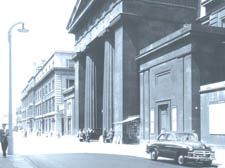|
|
 |
| |

The Euston Arch was pulled down in 1961 as iconic architecture was demolished across the country |
Arch enemies of architecture
The German Luftwaffe wasn’t solely responsible for despoiling London’s landscape during the last century – and the damage could go on,
writes Martin Sheppard
IT has long been a question whether the Germans or the British did more damage to the cities of Britain in the 20th century.
What Gavin Stamp’s evocative survey of architectural losses in 19 cities brings out is the frequent collusion between the two.
Following bombing raids in the Second World War, which left major buildings damaged rather than flattened, city planners often made a speedy decision to pull down whatever was still standing. Having thus summarily rejected any possibility of restoration, they later cleared the areas around the vanished buildings to make space for utopian monstrosities.
The other villain in the plot was the car. City planners, who were often surveyors or engineers rather than architects, were in thrall to the idea that cities must be made accessible to traffic, with new roads driven into and through historic centres.
Councils, armed from 1943 with compulsory purchase orders and sold on the idea of progress, were easily led. The planners’ path was eased by the manifest need to build new houses and better roads after the war; by architects and developers happy to work in concrete; and by a public kept at bay by specialists who regarded affection for old buildings as sentimental. Good intentions did more damage than corruption, though the career of T Dan Smith in Newcastle showed that the latter could not be discounted.
Most of this, exposed in the light of the rise of conservation and a growing public awareness of the need to preserve the best of the past, is well known. In Britain’s Lost Cities, however, Gavin Stamp shows with exceptional clarity and memorable detail how and why the cities effectively mutilated themselves.
The losses are illustrated by superb photographs of buildings and streets that have disappeared.
What has replaced them is described, and easily imagined, but not shown.
What is harder to imagine nowadays is the outlook that allowed this to happen. Much of it stemmed from a rejection of 19th-century architecture, widely characterised as heavy, vulgar and odd. (As Sir John Summerson wisely observed, “No building touches the heart until one century at least has passed over its roof.”) In London it led to the wrecking of Regent Street, to the destruction in 1961 of Philip Hardwick’s Doric arch at Euston, and almost to the loss of St Pancras.
The disdain for the past extended to Georgian buildings, with Liverpool making no attempt to save its magnificent Custom House and Edinburgh pulling down George Square.
Mirroring this, the cities of the North, including Bradford, Glasgow, Hull, Leeds, Manchester and Newcastle, rejected and then destroyed much of their own industrial and commercial heritage in an exercise of corporate self-loathing.
Where masterpieces were in danger, decent, well-built terraces and handsome streets stood little chance of survival. As Birmingham’s planning officer Herbert Manzoni put it with disarming candour in 1957: “I have never been very certain as to the value of tangible links with the past.”
Although the Germans no longer bomb us, and although architects now pay at least lip-service to the past, there are still real dangers to our urban environment.
Government plans to commercialise parks threaten one of Victorian England’s greatest legacies, while the Mayor of London’s seeming freedom to license skyscrapers at may soon blight central London.
|
 |
|
 |
 |
|
 |
|